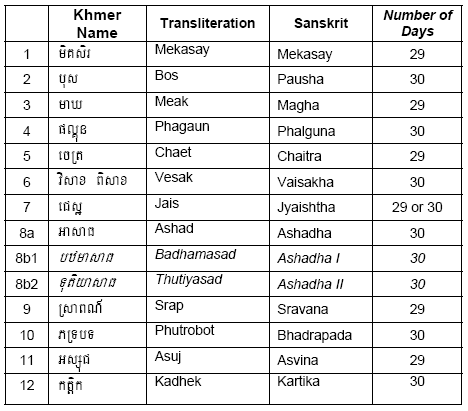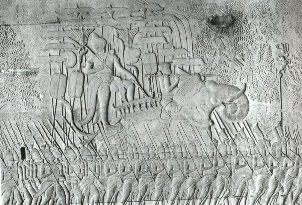Videos on Angkor Wat | Download PDF
Ancestor worship in September-October
A follower of Visnu is enjoined to perform the sraddha rites with the remnants of food first offered to Visnu. The Padma-purana enjoins that deities other than Visnu and the fathers may be propitiated with food that has been first offered to Visnu. In that same text Narada says, "Following the ordinances of the Sattvata School, the devotees first worshiped Visnu, the God of gods, and with the remnants of such food worshiped the fathers." In the Brahmanda-purana it is enjoined that the father's remain gratified for thousands of kalpas with rice cakes mixed with sacred blossoms of tulasi, prepared with the remnants of food offered with devotion to Visnu. In the Skanda-purana, Siva says, "Food should first be offered to Visnu and then the very same food should be distributed to the minor deities and the fathers." In the Purusottama-khanda of that same text, it is stated, "For avoiding defilement, the remnants of food offered to Visnu should be mixed with the rice cakes to be offered to the fathers. Food is rendered pure when sprinkled with the waters of the tulasi and when mixed with the food offered to Visnu." In the course of a conversation between Brahma and Narada it has been made clear that the worship of Visnu alone is capable of releasing the fathers from the suffering of hell." It is even stated that the performance of the sraddha rite is useless in the age of Kali without first worshipping Visnu.
This series of quotations from various Puranas reflects the Pancaratrika idea that through a person's sole reliance on Visnu all things that a human being would otherwise have to do alone could be accomplished through the grace of God. The successful outcome of the sraddha process was therefore, not dependant on the power of the ritual, the expertise of the priest, precise timing, and availability of the articles, etc. but upon God alone. This approach involved the 'handing over' of the fate of the soul to God.
According to this approach, food or water that is offered to the pitrs is first offered to Visnu and thereby transformed into visnu-prasada. The word prasada means "mercy" or "grace." Thus visnu-prasada is God's grace. This prasada of Visnu is then offered to the pitrs, who now receive God's grace instead of mere food or water. In this way, the grace of God has the power to elevate and sustain the pitrs in a manner that no human power can match. In the case of a homa or havan, a ritual performed with fire, the fire is used as the "delivery system" by which Visnu is first offered food. This food offering, which is now God's grace, is then offered to the pitrs through the fire. It is thus Agnideva, the fire God, who acts as the link between this world and the world of the pitrs.
Pitru Paksha ("fortnight of ancestors"), is the period when the family remembers all its ancestors and offers Tarpan to them. This period falls just before the Navratri or Durga Puja falling in the month of Ashwin (Hincu calendar). Mahalaya marks the end of the fortnight-long Tarpan to the ancestors. Mahalaya Tarpan is on September 27, 2011.
In Khmer tradition, Pchum Ben is celebrated between October 7 and 9 that is 14 and 15 of Phutrobot (Bhadrapada) and 1 of Asuj [Phutrobot (Bhadrapada) and Asuj (Asvina) are lunar months according to the following calendar of 12 months]:
 Songkran in Thailand (saMkrama m. Sanskrit. संक्रमः The passage of a planetary body through the zodiacal signs; दिनक्षये व्यतीपाते संक्रमे$र्कदिने$पि वा Bhāg.4.12.49.) संक्रमणम् 1 Concurrence. -2 Transition, progress, passing from one point to another. -3 Passage. -4 The sun's passage from one zodiacal sign to another. संक्रान्तिः f. The passage of the sun or any planetary body from one zodiacal sign into another.-- Songkran is the traditional Thai New Year, generally celebrated as a water festival. Be prepared to get wet all over as revelers abound, ready to soak you as a form of celebrating this season!
Songkran in Thailand (saMkrama m. Sanskrit. संक्रमः The passage of a planetary body through the zodiacal signs; दिनक्षये व्यतीपाते संक्रमे$र्कदिने$पि वा Bhāg.4.12.49.) संक्रमणम् 1 Concurrence. -2 Transition, progress, passing from one point to another. -3 Passage. -4 The sun's passage from one zodiacal sign to another. संक्रान्तिः f. The passage of the sun or any planetary body from one zodiacal sign into another.-- Songkran is the traditional Thai New Year, generally celebrated as a water festival. Be prepared to get wet all over as revelers abound, ready to soak you as a form of celebrating this season!
Songkran 2012
Friday, 13 April 2012
Saturday, 14 April 2012
Sunday, 15 April 2012
The Tamil New Year follows the nirayanam vernal equinox and generally falls on 13 or 14 April of the Gregorian year. 13 or 14 April marks the first day of the traditional Tamil calendar and this remains a public holiday in both Tamil Nadu and Sri Lanka. Tropical vernal equinox fall around 22 March, and adding 23 degrees of trepidation or oscillation to it, we get the Hindu sidereal or Nirayana Mesha Sankranti (Sun's transition into nirayana Aries). Hence, the Tamil calendar begins on the same date in April which is observed by most traditional calendars of the rest of India - Assam, Bengal, Kerala, Orissa, Manipur, Punjab etc. This also coincides with the traditional new year in Burma, Cambodia, Laos, Sri Lanka, Bangladesh Nepal and Thailand.

King Jayavarman VII, National Museum, Phnom Penh, twelfth century. A number of similar statues have been found, and are also presumed to be his likeness. There is no intimation, in these statues, that the King was venerated or worshipped in a temple. In the Pancaratra tradition of temple construction and consecration of murti-s, artistic embellishments are invariably found in all murti-s to connote their sacredness (such as a mukuta or ear or neck ornaments). Such embellishments are absent in the statues of King Jayavarman VII, thus belying the hypotheses of some scholars who claim that some temples were 'funerary temples'.
Sdok Kok Thom inscription K.194 identifies Divakarapandita as rajahotar of Suryavarman II. He had also served the previous two kings Jayavarman VI and Dharanindravarman I. (Coedes G. & Dupont P.,Les steles de Sdok Kak Thom, Phnom Sandak et Prah Vihar, BEFEO, XLIII, 1943: 145). It is a reasonable assumption that the themes and narratives of sculptures of the temple were chosen from Itihasa-Purana with the guidance of Divakarapandita. See notes on Inscription K. 235 of Sdok Kak Thom. (Appended)
 Soldiers descend from Mount S'ivapada. Inscription K.268 was translated by E. Aymonier (1904) and George Coedes (1911). Represented twice are the king, two of his ministers and the rajahotar. Total 19 dignitaries are shown: Vrah kmraten an - VKA (His Lordship) are six; kamraten an - KA (Lord) are two and Anak sanjak - AS(protectors of the king) are eleven. The inscription records 'tnvay kamraten an pandita' ('the presents from the honorable pandits'); 'samtac vrah pada kamraten an paravishnuloka na stt nau vnam S'ivapada pi pancuh vala' ('His Majesty Paramavishnuloka, at the moment when he is on Mt. S'ivapada to make the army descend'); VKA's are: 'Shri Virasinhavarman', 'Shri Jayendravarman Ldau'; 'Shri Virendradhipativarman Chok Vakula'; 'Shri Virayudhavarman'; 'Shri Mahipatindravaman Canlattai'; 'Shri Ranaviravarman'; 'Shri Rajasinhavarman'; 'Narapatindravarman'; 'Shuradhiparivarman'; KA's are: 'Dhananjaya', 'Shri Varddha'; AS's are: Kancas Pryak, Mat Gnan ti hau; Vidyashrama ti hau; Virajaya, Aso Vnya Chlan to hau. Another message of the inscription is: 'Vrah pada kamraten Paramavishnuloka' ('The holy feet of his Grace Paramavishnuloka'. King Suryavarman II stands on the royal elephant turning his head back, accompanied by 15 parasols, five fans, six flywhisks, four banners and a standard with a statuette of Vishnu on the shoulder of Garuda
Soldiers descend from Mount S'ivapada. Inscription K.268 was translated by E. Aymonier (1904) and George Coedes (1911). Represented twice are the king, two of his ministers and the rajahotar. Total 19 dignitaries are shown: Vrah kmraten an - VKA (His Lordship) are six; kamraten an - KA (Lord) are two and Anak sanjak - AS(protectors of the king) are eleven. The inscription records 'tnvay kamraten an pandita' ('the presents from the honorable pandits'); 'samtac vrah pada kamraten an paravishnuloka na stt nau vnam S'ivapada pi pancuh vala' ('His Majesty Paramavishnuloka, at the moment when he is on Mt. S'ivapada to make the army descend'); VKA's are: 'Shri Virasinhavarman', 'Shri Jayendravarman Ldau'; 'Shri Virendradhipativarman Chok Vakula'; 'Shri Virayudhavarman'; 'Shri Mahipatindravaman Canlattai'; 'Shri Ranaviravarman'; 'Shri Rajasinhavarman'; 'Narapatindravarman'; 'Shuradhiparivarman'; KA's are: 'Dhananjaya', 'Shri Varddha'; AS's are: Kancas Pryak, Mat Gnan ti hau; Vidyashrama ti hau; Virajaya, Aso Vnya Chlan to hau. Another message of the inscription is: 'Vrah pada kamraten Paramavishnuloka' ('The holy feet of his Grace Paramavishnuloka'. King Suryavarman II stands on the royal elephant turning his head back, accompanied by 15 parasols, five fans, six flywhisks, four banners and a standard with a statuette of Vishnu on the shoulder of Garuda

 A carved pedestal supports a linga. Tra Kieu. Ht. 43 cm. (Courtesy Paisarn Priemmattawat). Tra Kieu was known as Simhapura to the Chams. Glover (Glover, I.C., 1997, The excavations of J.Y. Claeys at Tra Kieu, Central Vietnam, 1927-28 from the unpublished archives of the EFEO, Parts and records in possession of the Claeys family, JSS 85: 173-86) identified the settlement to the 5th and 6th centuries, with initial occupation in the last two or three centuries BCE. A fragment of pottery from the lowest layer has been identified as rouletted ware closely paralleling Arikamedu finds in India. This suggests maritime exchange was in place during the late first millennium BCE. (cf. Charles Higham, Early cultures of Mainland Southeast Asia, Chicago, Art Media Resources Ltd., p. 273)
A carved pedestal supports a linga. Tra Kieu. Ht. 43 cm. (Courtesy Paisarn Priemmattawat). Tra Kieu was known as Simhapura to the Chams. Glover (Glover, I.C., 1997, The excavations of J.Y. Claeys at Tra Kieu, Central Vietnam, 1927-28 from the unpublished archives of the EFEO, Parts and records in possession of the Claeys family, JSS 85: 173-86) identified the settlement to the 5th and 6th centuries, with initial occupation in the last two or three centuries BCE. A fragment of pottery from the lowest layer has been identified as rouletted ware closely paralleling Arikamedu finds in India. This suggests maritime exchange was in place during the late first millennium BCE. (cf. Charles Higham, Early cultures of Mainland Southeast Asia, Chicago, Art Media Resources Ltd., p. 273)
| << Previous Page | Next Page >> |
